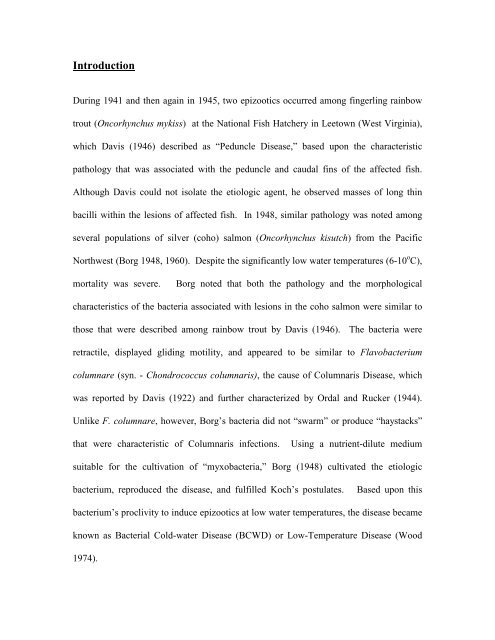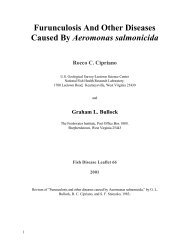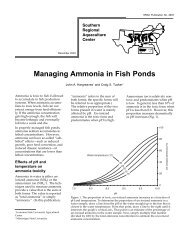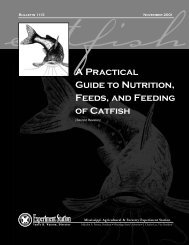Flavobacterium psychrophilum, cause of ... - cop.eXtension.org
Flavobacterium psychrophilum, cause of ... - cop.eXtension.org
Flavobacterium psychrophilum, cause of ... - cop.eXtension.org
You also want an ePaper? Increase the reach of your titles
YUMPU automatically turns print PDFs into web optimized ePapers that Google loves.
Introduction<br />
During 1941 and then again in 1945, two epizootics occurred among fingerling rainbow<br />
trout (Oncorhynchus mykiss) at the National Fish Hatchery in Leetown (West Virginia),<br />
which Davis (1946) described as “Peduncle Disease,” based upon the characteristic<br />
pathology that was associated with the peduncle and caudal fins <strong>of</strong> the affected fish.<br />
Although Davis could not isolate the etiologic agent, he observed masses <strong>of</strong> long thin<br />
bacilli within the lesions <strong>of</strong> affected fish. In 1948, similar pathology was noted among<br />
several populations <strong>of</strong> silver (coho) salmon (Oncorhynchus kisutch) from the Pacific<br />
Northwest (B<strong>org</strong> 1948, 1960). Despite the significantly low water temperatures (6-10 o C),<br />
mortality was severe. B<strong>org</strong> noted that both the pathology and the morphological<br />
characteristics <strong>of</strong> the bacteria associated with lesions in the coho salmon were similar to<br />
those that were described among rainbow trout by Davis (1946). The bacteria were<br />
retractile, displayed gliding motility, and appeared to be similar to <strong>Flavobacterium</strong><br />
columnare (syn. - Chondrococcus columnaris), the <strong>cause</strong> <strong>of</strong> Columnaris Disease, which<br />
was reported by Davis (1922) and further characterized by Ordal and Rucker (1944).<br />
Unlike F. columnare, however, B<strong>org</strong>’s bacteria did not “swarm” or produce “haystacks”<br />
that were characteristic <strong>of</strong> Columnaris infections. Using a nutrient-dilute medium<br />
suitable for the cultivation <strong>of</strong> “myxobacteria,” B<strong>org</strong> (1948) cultivated the etiologic<br />
bacterium, reproduced the disease, and fulfilled Koch’s postulates. Based upon this<br />
bacterium’s proclivity to induce epizootics at low water temperatures, the disease became<br />
known as Bacterial Cold-water Disease (BCWD) or Low-Temperature Disease (Wood<br />
1974).






